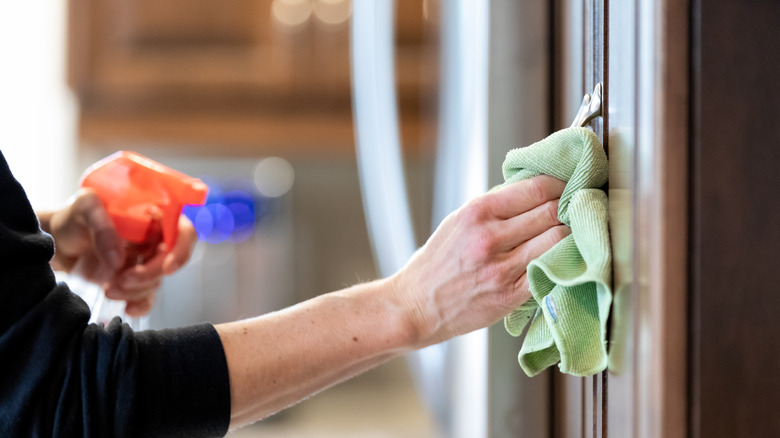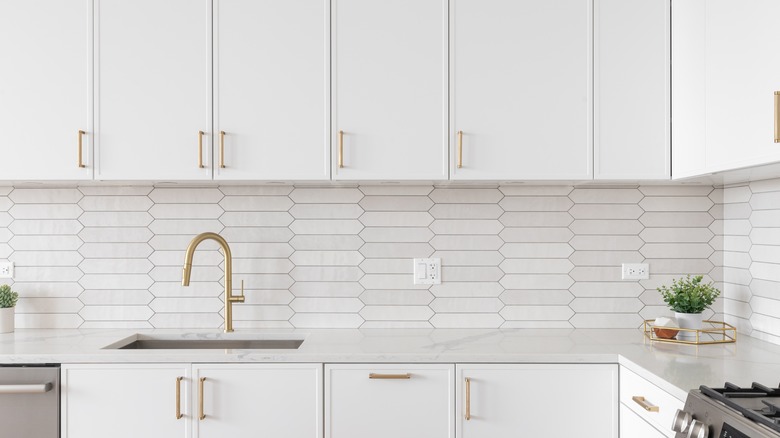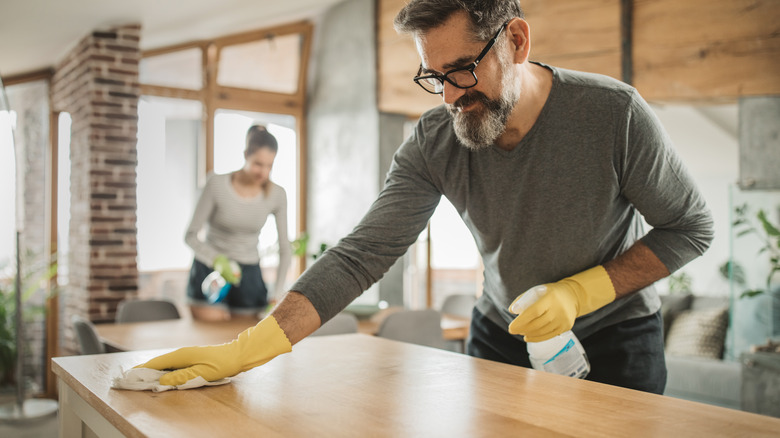The Best Way To Clean That Nasty Grease Off Of Your Kitchen Cabinets
Keeping a busy kitchen clean is no easy task. Even if you're keeping up with the day-to-day maintenance cleaning in your kitchen, it's still important to do a deep clean every month or so. Even surfaces that don't come in contact with food will start to collect dirt and residue, including kitchen cabinets. Every time you cook, grease from the stove and oven mixes with steam and becomes airborne, and over time, your cabinets will start to collect a dull sheen. The good news is that it's easy to wipe away all of the cooking residue that's built up on your cabinets with products you probably already own: good old liquid dish soap, or baking soda.
There's not much you can do to prevent greasy gunk from collecting on your cabinets, especially if you like to cook. Thankfully, removing the offending film takes just a few minutes, and you don't need any special tools — just a sponge and some paper towels or a kitchen rag.
Use dish soap or baking soda
If you notice gunk collecting on your cabinets, all you need to freshen up your cabinets is a kitchen sponge, water, and a good liquid dish detergent (as long as the film isn't too thick, that is). The surfactants in the soap will lift away the grease the same way it does for dishes.
Get your sponge soapy with hot water and simply scrub the cabinet surfaces. If you have a lot of surface area to cover, fill a bowl or a small bucket with some soapy water so that you can refresh the sponge while you work. After you've scrubbed the gunk to lift it off the surface of the cabinet, wipe away the residue with a kitchen towel or paper towels.
If you scrub the surfaces of your cabinets with soap and water and the crud doesn't budge, no problem. Grab a box of baking soda and make a solution of 1 part baking soda to 2 parts warm water. It's okay if not all of the baking soda dissolves in the water — you'll need a little grit for scrubbing. Dip your sponge into the water, get a little baking soda on your sponge, and scrub the surfaces of your cabinets. When you've got all of the grime removed, wipe the surfaces down with a wet towel to remove any baking soda residue, which will dry and look like white streaks if you leave it behind.
Regular maintenance
You might think you're done cleaning the kitchen when you've scrubbed all the grout in the backsplash and washed all the shelves in the refrigerator. There are tons of places where dirt and grime can collect in your kitchen, however, that don't even come in contact with food.
Every time you cook, more greasy film collects inside your oven and leaves baked-on gunk. This film also collects anywhere that steam can go, especially the surfaces near the stove, as well as out-of-reach cabinets. Surfaces and hardware also pick up dirt and grime from dirty fingers and spills, so don't neglect your cabinets just because you don't use them to cook.
The best way to battle the cabinet grunge is to wipe them down more often so that the grease doesn't set in. Make it a regular practice to wipe down the cabinets closest to the stove with a spritz of all-purpose cleaner or a soapy sponge after you finish cooking, and make sure the cabinets that are up high are a part of your regular deep cleaning rotation, too.


